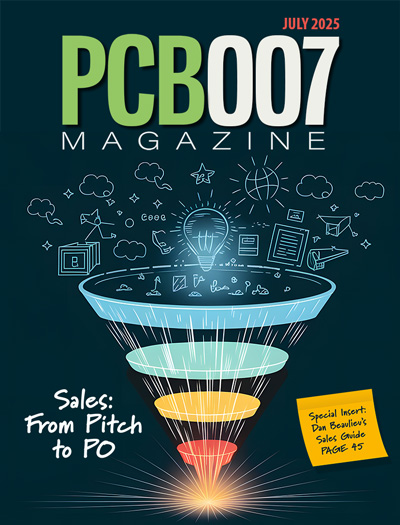-

-
News
News Highlights
- Books
Featured Books
- pcb007 Magazine
Latest Issues
Current Issue
Sales: From Pitch to PO
From the first cold call to finally receiving that first purchase order, the July PCB007 Magazine breaks down some critical parts of the sales stack. To up your sales game, read on!

The Hole Truth: Via Integrity in an HDI World
From the drilled hole to registration across multiple sequential lamination cycles, to the quality of your copper plating, via reliability in an HDI world is becoming an ever-greater challenge. This month we look at “The Hole Truth,” from creating the “perfect” via to how you can assure via quality and reliability, the first time, every time.

In Pursuit of Perfection: Defect Reduction
For bare PCB board fabrication, defect reduction is a critical aspect of a company's bottom line profitability. In this issue, we examine how imaging, etching, and plating processes can provide information and insight into reducing defects and increasing yields.
- Articles
- Columns
- Links
- Media kit
||| MENU - pcb007 Magazine
All About Flex: Soldering Flexible Circuits
August 25, 2016 | Dave Becker, All FlexEstimated reading time: 3 minutes
The most common methods for component attachment on flexible circuits and rigid printed circuit boards involve soldering. The basic principles for soldering are the same for both flex and hard board, but soldering components to flexible circuits involves certain specific considerations vs. our rigid cousins. The nuances are related to material handling and flexibility; reflowed solder is not flexible and can fracture under the various stresses a circuit may experience. Flexible circuits are also more likely to absorb water as polyimide is hydroscopic. With this condition, pre-baking the circuitry prior to soldering at 105°C for 30–60 minutes is recommended to ensure delamination will not occur from thermal shock. This is especially true in high humidity conditions. In addition, adhesive systems use different formulations on flexible circuits vs. hardboards and this sometimes creates hand soldering challenges. As a result, design layout and manufacturing techniques for flex circuit soldering need to be slightly different vs. rigid PCBs.
Design/Layout Considerations
Bending, twisting and flexing can put a great deal of mechanical stress on the trace and solder in areas near bend or transition points. Additionally, the adhesive system that bonds copper to the dielectric substrate (often acrylic or a modified epoxy) has been formulated to provide different properties vs. the epoxy adhesive system used for the vast majority of rigid printed circuit boards. The epoxy adhesive for a rigid PCB is cast onto reinforcement strands of a glass fiber carrier. Curing the epoxy with the glass creates a rigid substrate. But in order for a flexible circuit to flex, the adhesive system needs to allow movement. So the adhesive system for a flexible circuit is “softer” and less cohesive than the adhesive system for a PCB. When exposed to the high temperatures of the soldering iron, the adhesive system may soften a bit. In order to compensate for this, many design guides recommend a design feature known as “anchor spurs” or tie downs as shown in Figure 1.
Solder joints should not be subjected to the stress of bending. It is a good idea to make sure that flex points are far enough away from the solder pad to prevent stress. Figure 2 shows the issue with a plated via, but the same issue applies to a solder filet. The bend radius guideline using 10X the material thickness is a safe rule for repeated flexing. Flexible circuits are often folded onto themselves in one time bend applications.
Since a flexible circuit can easily conform to surface irregularities, it is important to consider if the solder joint will match up with potential stress points. One example is shown it Figure 3. The end of the stiffener creates a stress point directly under the solder joint. This situation should be avoided.
Soldering Techniques
Even with the design optimized for solder joints, the soldering methods for flexible circuits may need to differ from a rigid printed circuit board. In hand soldering, operators must use a bit more care when soldering to flex than when soldering to a rigid PCB. In either case, only a minimal amount of solder iron pressure is needed to form a good solder joint. There is less latitude for excess solder tip pressure with flexible circuits as pressure can cause the pad to slide or move when the heat temporarily softens the adhesive. Excess temperature or dwell can also cause the copper pad to delaminate from the film coverlay and/or substrate. Adhesiveless laminates have become much more popular during the past 10 years and are more robust when exposed to soldering temperatures.
SMT assembly is a little different with flex. Rigid printed circuit boards can be easily held and shuttled since they are mechanically robust enough to be lifted by the edges and placed onto a conveyor. Flexible circuits are flimsy and often require fixturing or modifications to be compatible with the SMT handling system to shuttle the flexible panel through the solder dispense, SMT placements and reflow ovens.
Wave soldering flex will usually require special fixturing. Normally the flexible panel is positioned on top of a rigid surface, “solder side” down, where there are openings milled out to expose the areas to be soldered.
In both the cases of SMT soldering and wave soldering, there are usually several duplicate fixtures needed to assure equipment productivity as fixtures are not available for reuse until circuits go through the entire process. Fixturing and tooling used for SMT assembly and wave soldering are quoted as part of the total tooling package. The fixturing can vary significantly in complexity and cost depending on the circuitry configuration, component types, tolerances and locations.
Dave Becker is the V.P. of sales and marketing at All Flex Flexible Circuits and Heaters. To contact Becker, or read past columns, click here.
Testimonial
"Advertising in PCB007 Magazine has been a great way to showcase our bare board testers to the right audience. The I-Connect007 team makes the process smooth and professional. We’re proud to be featured in such a trusted publication."
Klaus Koziol - atgSuggested Items
MacDermid Alpha Electronics Solutions Unveils Unified Global Website to Deepen Customer, Talent, and Stakeholder Engagement
07/31/2025 | MacDermid Alpha Electronics SolutionsMacDermid Alpha Electronics Solutions, the electronics business of Elements Solutions Inc, today launched macdermidalpha.com - a unified global website built to deepen digital engagement. The launch marks a significant milestone in the business’ ongoing commitment to delivering more meaningful, interactive, and impactful experiences for its customers, talent, and stakeholders worldwide.
KOKI to Showcase Analytical Services and New HF1200 Solder Paste at SMTA Guadalajara 2025
07/31/2025 | KOKIKOKI, a global leader in advanced soldering materials and process optimization services, will exhibit at the SMTA Guadalajara Expo & Tech Forum, taking place September 17 & 18, 2025 at Expo Guadalajara, Salón Jalisco Halls D & E in Guadalajara, Mexico.
Weller Tools Supports Future Talent with Exclusive Donation to SMTA Michigan Student Soldering Competition
07/23/2025 | Weller ToolsWeller Tools, the industry leader in hand soldering solutions, is proud to announce its support of the upcoming SMTA Michigan Expo & Tech Forum by donating a limited-edition 80th Anniversary Black Soldering Set to the event’s student soldering competition.
Koh Young Appoints Tom Hattori as President of Koh Young Japan
07/21/2025 | Koh YoungKoh Young Technology, the global leader in True 3D measurement-based inspection solutions, announced the appointment of Tom Hattori as President of Koh Young Japan (JKY).
Silicon Mountain Contract Services Enhances SMT Capabilities with New HELLER Reflow Oven
07/17/2025 | Silicon Mountain Contract ServicesSilicon Mountain Contract Services, a leading provider of custom electronics manufacturing solutions, is proud to announce a significant upgrade to its SMT production capability with the addition of a HELLER 2043 MK5 10‑zone reflow oven to its Nampa facility.


